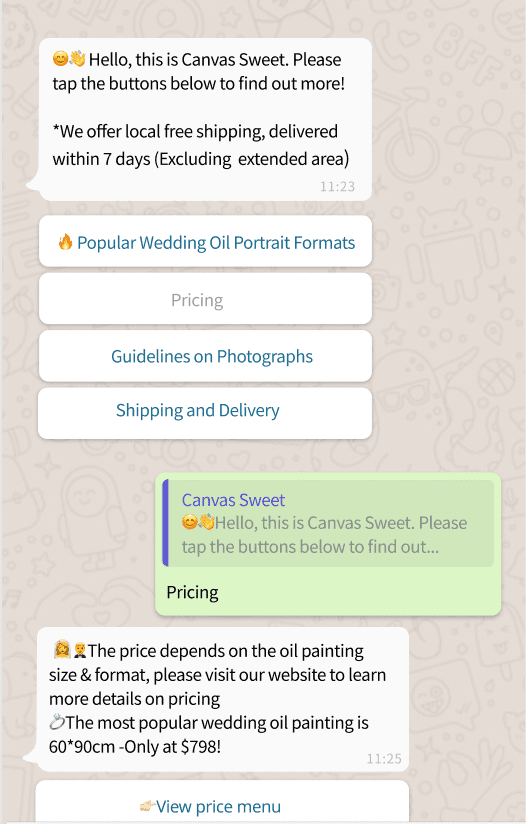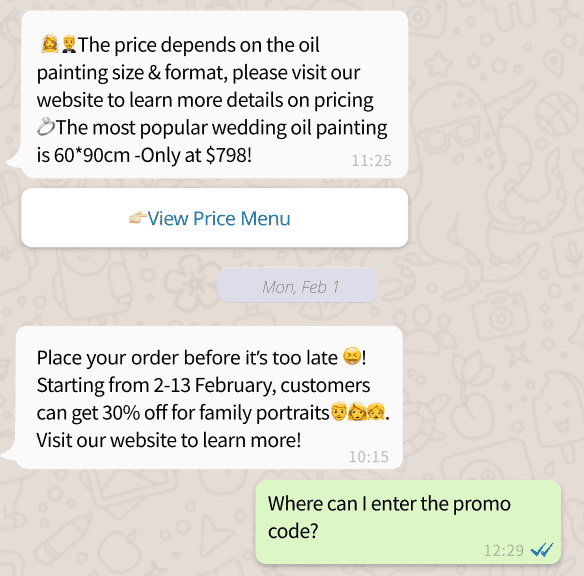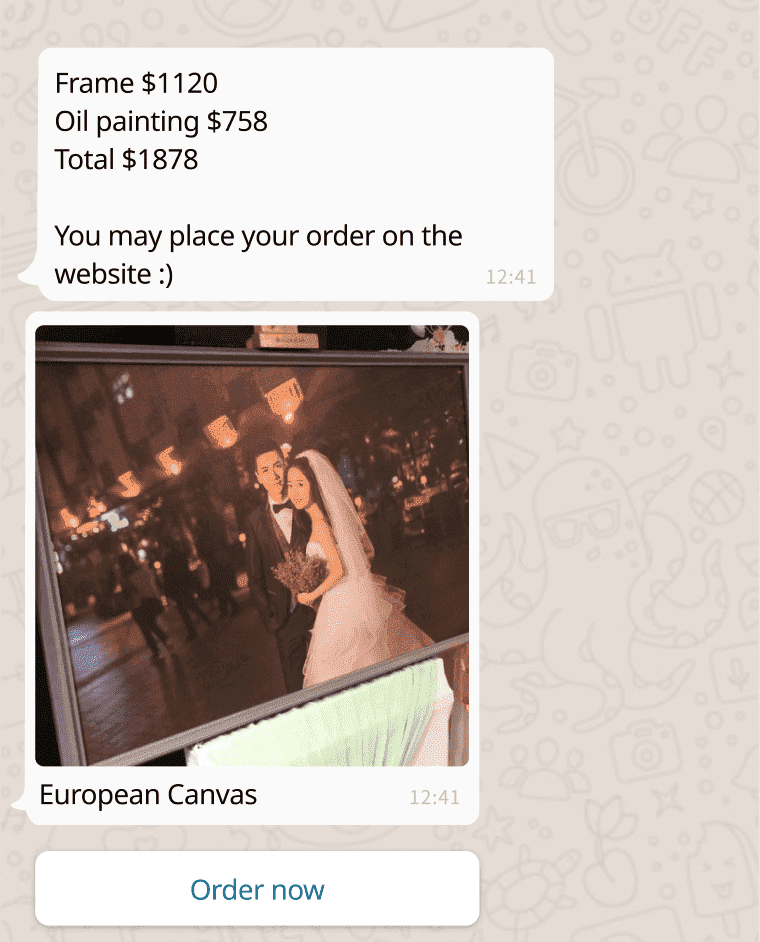Conversational Commerce
According to Statista’s prediction, global spending on conversational commerce channels is expected to increase seven times by 2025, reaching almost $290 billion. Additionally, Instagram CEO Adam Mosseri stated in an Instagram Story that messaging, commerce, and video will be Instagram’s top product feature priority in 2022.
Conversational commerce is often referred to as chat commerce or conversational marketing. Online stores can employ conversational commerce to leverage the opportunity to sell products and services during conversations. This method has many forms. Whether you connect with customers using chat apps, chatbots, voice assistants, or other platforms is inconsequential. Practically assisting customers and engaging them quickly through the sales funnel will suffice. Furthermore, the conversational experience must be convenient and tailored enough to be effective.
How and where can you employ conversational commerce?
Chris Messina, an American blogger, originally used the term “conversational commerce” in a 2015 Medium piece. The article highlights the trend of instant messaging applications for sales. With a growing user base, instant messaging apps have become increasingly popular. Like WhatsApp, which has more than 6.6 million users only in Hong Kong and over 2 billion active users worldwide. This makes WhatsApp the number 1 messaging application. These figures show marketers that the best way to interact with consumers is through communication. Customers should no longer be forced to visit a brand’s website; instead, they can use popular instant messaging platforms.
Additionally, online retailers frequently have to choose between search engine optimization (SEO) and content that reflects user preferences. SEO is a strategy that aids in improving your online store’s Google ranking and boosting traffic. Such SEO-optimized writing, though, can be monotonous and impersonal. Conversational commerce, which enables online retailers to balance SEO and customer satisfaction, is addressing this issue. It focuses on personalizing the brand’s business experience as well as SEO requirements. This makes it possible for customers to contact brands at any time through mobile applications.
Further reading: 5 Ways to Engage Customers Using Chatbot
Five Benefits of Conversational Commerce to Online Stores
Customers can communicate with online stores through messaging applications, live chat, chatbots, and voice technology because of conversational commerce. In these channels, customers can communicate for customer service, and product information, as well as make purchases.
As a one-to-one sales channel, conversational commerce can offer consumers the specialized services they require. According to studies, the proper application of conversational commerce can boost online retailers’ yearly income by 7% to 25%. Below are some statistics regarding customer preferences in online stores.
- 53% of consumers are more likely to shop online at stores where they may leave a message.
- 82% of customers think that when contacting an online store, getting instant responses is important.
- 91% of customers are more inclined to make a purchase from an online store that keeps track of customer preferences. Services may also include product recommendations and pertinent offers.
Furthermore, here are the top 5 benefits of Conversational Commerce for online stores:
1. Reduces shopping cart abandonment
The fact that up to 70% of shopping carts are abandoned by customers causes the biggest headache for online businesses. High delivery fees are among the most frequent reasons given by customers for abandoning their purchases. Moreover, some customers decide not to complete their purchases because of lengthy checkout procedures or restrictions for account creation. How can conversational commerce help online stores lower their abandonment rates?
Merchants can proactively send greetings to customers who have added items to their carts but are yet to make a purchase. To assist consumers in completing their orders, this can be done using live chat. Using the Facebook Messenger Checkbox plugin, for instance, merchants can identify active Facebook sessions. Through this plugin, you can communicate with users who are yet to finish an order.
Wa.me allows businesses that use WhatsApp to generate links and directly send messages to customers without adding contacts. Even discounts might be given to customers to encourage them to place additional orders on the website.
Further reading: How WhatsApp Chat Links Can Save Your Time and Enhance Ad Performance
2. Lessens platform-to-platform price comparisons
Conversational commerce is a terrific technique to persuade reluctant customers to make a purchase right away. Instead of just leaving a string of calls, consumers will be more likely to purchase from a company that offers them informational options.
As an alternative, retailers can provide seasonal discounts, personalized live chat greetings, and professional advice. Customers can even be provided with the information that they need to complete their purchasing decision.
If customers have questions regarding payment options or return policies while checking out, merchants can utilize chatbots to connect with them. Likewise, it’s simpler to switch to a live sales representative if the customers need further answers. Through chatbots, customers can also learn about product price changes and get timely price drop notifications!
3. Gathers feedback
Customers’ feedback and suggestions are crucial for businesses looking to enhance the quality of their services. Operators of online stores can quickly gather customer feedback by chatting. Creating a new post to promote the brand offer is the most typical method. The individual who left the message will then be given a promise of additional information. Finally, each customer will receive personalized messages from a chatbot, including the option to provide feedback.
For instance, businesses can communicate with individuals who have left comments on Facebook posts using the Facebook Post Reply Tool. Creating a new post to promote the brand offer is the most typical method. The individual who left the message will then be given a promise of additional information. Finally, each commenter will receive personalized messages from a chatbot, including the option to provide feedback.
Additionally, merchants can consider sending surveys using messaging apps like WhatsApp. After the chat is over, they can immediately start gathering feedback to help them understand more about customer demands.
4. Up-selling & Cross-selling
By upselling and cross-selling more products to customers who are ready to buy, online retailers can boost earnings.
According to data, for instance, when given personalized product recommendations via LiveChat, 59% of customers believe that this has a major influence on their decision to make a purchase.
Online retailers may also proactively contact customers with purchase history through WhatsApp chatbots. This promotes cross-selling by reminding consumers that new products are now available to complement their prior purchases. It can also remind customers that the last product purchased may have run out and needs to be replenished.
Further reading: B2B E-commerce: The Secret to Personalized Marketing
5. Helps build customer loyalty
By actively assisting first-time consumers, conversational commerce can help you capitalize on the chance to make a favorable impression. Whilst guiding them in the remaining stages of the customer journey, online retailers may foster stronger customer connections and develop trust. According to HubSpot, 90% of consumers are more likely to make larger purchases from their preferred brands.
A WhatsApp chatbot, for instance, can be used by an online store to share promotional coupons. Customers enjoy receiving promotional coupons, and they are also more likely to connect with retailers who offer them.
How Conversational Commerce Helps Online Stores Build Connections at Different Stages of the Customer Journey
Online retailers may communicate with customers at every stage of the purchasing process in conversational commerce. This method of sales, as opposed to pushy pop-ups and banners, initiates discussions with potential consumers and fosters better relationships.
Awareness and discovery, measurement, imagery, conversion, and loyalty are the five phases of the consumer journey. Online retailers may connect with customers at every stage by utilizing conversational commerce technologies and methods. They might even enhance the shopping experience and transform each interaction into a long-lasting connection.
1. Awareness & Discovery: Attract customers and introduce business
The first stage in marketing is awareness. Once consumers become aware of a problem or a need, they begin hunting for a solution online. Your online store might come to the attention of the customer during this process.
The most crucial phase of the entire journey is the awareness stage. Otherwise, customers won’t be able to make a purchase even if the goods are excellent and the page is stunning.
Conversational tools allow you to connect with customers who are just beginning their journey and are actively looking for suppliers. Online shops may employ chat tools to show customers that they comprehend their needs and can provide solutions. This supports customers in completely comprehending the products and commercial content you offer. The Canvas Sweet example below shows how you automatically reply via WhatsApp Chatbot, and easily make contact with new consumers.

2. Evaluation: Customer evaluation and comparison of brand quality
The customer has done some basic research and is familiar with you at this point. However, their quest for knowledge is yet to be over. They continue to research your brand, evaluate your competitors, and read user reviews. You can harness the power of dialogue to give them more information during the consideration stage. This enables them to better understand your offer. For instance, in the case of Canvas Sweet, the retailer may decide to utilize a chatbot. This can be done if the customer does not take any further action after checking the price. To entice customers to make a purchase, the company may also decide to use a chatbot to offer discount information.

3. Intent: Customers are genuinely interested in the brand
This is the phase when the customer is ready to buy. The online retailer must actively reassure the customer that they made the proper decision even after they finalize the transaction. They must make sure the customer can have the desired product and the highest caliber of service. Consumers will not change their minds since they perceive this as “excellent value for money.” You must carry on the dialogue at this point in order to support the customer’s choice. By taking the initiative to display the honest assessments of other users, you can provide social proof. To increase customers’ trust in online shops and products, you may utilize VIMOS as an example and employ a herd mentality.
4. Conversion: The customer officially buys!
If the customer has made it to this point, the store has already essentially met all of their needs. You can still achieve breakthroughs despite this, nevertheless. Data demonstrates that giving customers special attention at this time can be quite advantageous. This keeps an existing customer costing five times cheaper than obtaining a new one. Online retailers must occasionally send information to customers and respond to their messages in order to maintain positive communication. Even if it is a bad review of the product, this is still important.

5. Loyalty: Building long-term relationships
The hardest aspect of an online store to reach is this final phase of the customer journey. Customers now act as brand ambassadors, suggesting your products to friends and family on their own initiative. Online retailers deserve this reward, and if buyers skip any step along the way, their enthusiasm will falter.
Online shops can still communicate with customers, nevertheless, to get further advantages. This involves proactively asking customers to offer endorsements or product reviews, like in the case of Canvas Sweet. Customers develop stronger bonds with one another and feel like they are a part of your team as a result.
Further reading: Only 5% of online merchants are successful: their three entrepreneurial secrets
How VIMOS Facilitates Conversational Business

WhatsApp auto-reply after-sales service without waiting
- Reduces waiting times, attends to customer issues right away, and dramatically improves customer happiness and loyalty.
- Chatbot 24/7 to handle after-sales service
- Automatic messages enable visitors to independently leave relevant information to increase response effectiveness.
Multi-person login to improve work efficiency
- By designating the most qualified personnel to handle inquiries whenever they arise, you can get around the bottleneck of customer service. Employees can carry on with business as usual even if they are on vacation or misplace their work phones.
- Multiple logins, complement each other at any time
- Real-time tracking of staff workload and conversation quality
WhatsApp broadcast remarketing without manually saving phone numbers
- Add corresponding tags to guests to personalize messages, improve publicity efficiency and effectiveness, and broadcast in batches with one click
- Official API broadcast without blocking
- Add interactive buttons to broadcast content to improve affiliate promotion
- Easily get good service reviews
Do you think the conversational commerce project is too big and impossible to start? Are you having trouble selecting the ideal partner platform for your online store?
VIMOS, Hong Kong’s #1 retail marketing platform, offers a personalized experience to support the growth of your online-to-offline business prospects. Leverage the power of a 7-day free trial by scheduling a VIMOS product demonstration today!










